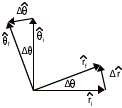In class, we use Cartesian coordinates for all our work. Most of the time, this is the easiest coordinate system to use. It is important to realize that the choice of a coordinate system should make the problem easier to use. We see this when we do problems involving inclined planes, where it is easier to use a coordinate system that is “parallel” and “perpendicular” to the inclined plane. Sometimes it very useful to use polar coordinates instead of Cartesian; especially when the problem involves quantities that change only with the radius.

The point (x,y) would be given in polar coordinates by the pair (r, q), as shown. It should be obvious from the diagram that we have the following relationships between the coordinates:
|
Cartesian to
Polar |
Polar to Cartesian |
|
|
|
Position Vectors
The fun begins when we wish to describe position vectors. In Cartesian coordinates, we would describe the position of an object at (x,y) with the vector
![]()
A unique aspect of Cartesian coordinates is that the unit vectors i and j always point in the same direction and are independent of each other. In polar coordinates, however, the two unit vectors, r and q, do depend on each other, and change their direction.

The unit vector in the radial direction is labeled ![]() , and the unit vector perpendicular to that is labeled
, and the unit vector perpendicular to that is labeled ![]() . The radial
unit vector always points away from the origin, so it actually points to
different directions depending on the value of q. The angular unit vector always points
perpendicular to the radial unit vector.
We could relate the polar unit vectors to the Cartesian coordinate
vectors with the following:
. The radial
unit vector always points away from the origin, so it actually points to
different directions depending on the value of q. The angular unit vector always points
perpendicular to the radial unit vector.
We could relate the polar unit vectors to the Cartesian coordinate
vectors with the following:
![]()
That means to write the position of an object in polar vector notation, we would simply write
![]()
This looks odd, but remember that the unit radial vector depends on q, and is not constant.
Velocity Vector in Polar Coordinates
The velocity of an object is found in Cartesian coordinates by
![]()
In polar coordinates, the velocity vector is given by
![]()
Remember that both the radius and the unit radial vector can change, hence the more complicated derivative than the Cartesian velocity.
So how does the unit radial vector change in time? To see this, the following diagram represents an initial and a final unit radial vector, and the change between is labeled ∆r.

In the limit as delta-time becomes zero, we can say that ![]() . The magnitude
of
. The magnitude
of ![]() is 1 (by
definition) and the direction of
is 1 (by
definition) and the direction of ![]() is in the
direction of
is in the
direction of ![]() . Looking at the
magnitudes, we have
. Looking at the
magnitudes, we have
![]() so that
so that ![]() ,
,
which in the limit becomes ![]()
Combining this with the direction, we have
![]()
Likewise, we can do the same thing to find an expression for
![]() . The magnitude
is the same, but the direction is opposite the unit radial vector, so that we
have
. The magnitude
is the same, but the direction is opposite the unit radial vector, so that we
have
![]()
We can substitute the first expression in to get the following expression for velocity in polar coordinates
![]()
The first term in the velocity is the radial velocity and the second term is the tangential velocity (which is often written as rw)
Acceleration Vector in Polar Coordinates
To find the expression for acceleration, we take the time derivative of the velocity, as follows

Substituting the expressions for the time derivatives of the unit vectors
![]()
So that we get the following expression for acceleration
![]()
The first two terms are the radial acceleration terms: the linear acceleration and the centripetal acceleration. The second two terms are the tangential acceleration terms: the linear tangential acceleration and the more obscure Coriolis acceleration.
Example
1. Suppose we have an object that travels in a circle of constant radius 3 meters with a constant angular velocity of 2 radians per second. What are the expressions for the position, velocity and acceleration as functions of time?
a. The position as a function of time is trivial: r(t) = 3 and q(t) = 2t.
In Cartesian coordinates, the position would be given by x(t) = 3cos(2t) and y(t) = 3sin(2t).
b. The velocity would be given by ![]() , so that
, so that
![]() .
.
The velocity would have a radial speed of 0 m/s and a tangential speed of 6 m/s, both of which were constant; i.e. the object would be traveling in a circle with a constant speed of 6 m/s.
In Cartesian coordinates, the velocity would be
![]() .
.
c. The acceleration would be
given by ![]() , so that
, so that
![]()
which is simply
![]()
The acceleration
has a constant magnitude of 12 m/s2 and is directed to the
origin. (Remember that positive ![]() points away from
the origin.) This is the
centripetal acceleration! Recall
that ac= v2/r, so that ac = (6)2/3
= 12. There is no tangential
component of the acceleration.
points away from
the origin.) This is the
centripetal acceleration! Recall
that ac= v2/r, so that ac = (6)2/3
= 12. There is no tangential
component of the acceleration.
In Cartesian
coordinates, the acceleration would be ![]()
